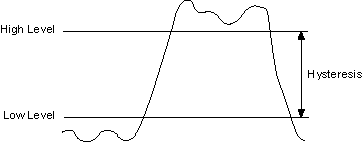Hysteresis
Hysteresis refers to the difference in voltage levels between the detection of a transition from a logic low level to a logic high level and the transition from a logic high level to a logic low level. Refer to the following figure illustrating hysteresis.

All digital logic devices have some level of hysteresis on their digital inputs. The magnitude of a particular device's hysteresis can be determined by the following formula:
Hysteresis ≈ VIH - VIL
On a rising edge of the digital signal on the input, the device detects a transition from a logic low to a logic high at VIH. Conversely, the device detects a transition from a logic high to a logic low when the voltage at the input of the device crosses VIL.
Hysteresis is a useful property for digital devices because it provides some amount of natural immunity to high-frequency noise in your digital system. This noise, often caused by reflections from the high edge rates of logic level transitions, could cause false transition detections by the digital device if only a single voltage threshold determined a change in logic state. This phenomenon is more clearly illustrated in the following figure.

In this figure, after applying hysteresis the first sample is acquired as a logic low level. The second sample is also a logic low level because the signal has not yet crossed the logic high level threshold. The third and fourth samples are logic high level, and the fifth is logic low level.
For devices with fixed voltage thresholds, the NIM and hysteresis of your system are determined by your choice of system components. Some NI devices allow you to control both your system NIM and hysteresis. Both system NIM and hysteresis give your system levels of noise immunity, but for a specific logic family, there is always a trade-off between these two—the larger the hysteresis, the smaller the NIM, and vice versa. To determine how to set your voltage thresholds, carefully examine the signal quality in your system to determine whether you need more noise immunity from your valid logic levels (greater NIM) or need more noise immunity on your logic level transitions (greater hysteresis).